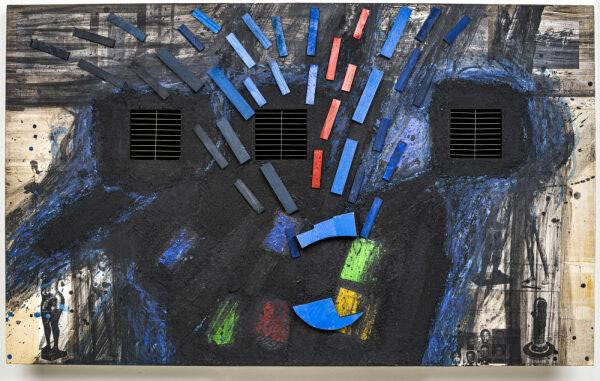 The current posthumous solo exhibition of works by Guyana-born artist Donald Locke (1930-2010) is one any Guyana-based artist or art lover would be overjoyed to see. Donald Locke: Nexus is currently on at Atlanta Contemporary (AC), formerly Nexus Contemporary Arts Center (Atlanta, USA) from 24 October 2024 to 2 February 2025. The exhibition spans Locke’s decades-long fruitful expressivity through art and includes several works produced during his Nexus studio tenure from 1992-1996. (Locke was one of 12 artists who occupied one of a similar number of studio spaces inaugurating two warehouses converted to studio spaces.) Along with the artwork on exhibition, separately displayed are ephemera and other contextualising material from the period. These were retrieved from the Stuart A Rose Manuscript, Archives, and Rare Book Library at Emory University where many critical writings, correspondences, and other material collected by Locke are archived.
The current posthumous solo exhibition of works by Guyana-born artist Donald Locke (1930-2010) is one any Guyana-based artist or art lover would be overjoyed to see. Donald Locke: Nexus is currently on at Atlanta Contemporary (AC), formerly Nexus Contemporary Arts Center (Atlanta, USA) from 24 October 2024 to 2 February 2025. The exhibition spans Locke’s decades-long fruitful expressivity through art and includes several works produced during his Nexus studio tenure from 1992-1996. (Locke was one of 12 artists who occupied one of a similar number of studio spaces inaugurating two warehouses converted to studio spaces.) Along with the artwork on exhibition, separately displayed are ephemera and other contextualising material from the period. These were retrieved from the Stuart A Rose Manuscript, Archives, and Rare Book Library at Emory University where many critical writings, correspondences, and other material collected by Locke are archived.
In a 1992 Atlanta newspaper article (on exhibit), Locke is quoted by the staff writer as saying, “This may sound pretentious, but I feel that this is the beginning, the nucleus of something.” The studio space allowed Locke to venture into large-scale, mixed-media paintings. During his tenure at Nexus, Locke also produced public works by commission and several works were acquired for important collections.

While Locke may be known locally by young artists and audiences as an artist and a teacher, his art criticism may not be. Amidst his writings are those for Creative Loafing in the late 1990s. Over two decades later, this exhibition of a selection of his work was announced as the critic’s pick for Atlanta in a January 2025 publication. In the article Creative Loafing’s Kevin C Madigan quotes AC Executive Director Floyd Hall: “This exhibition is a moment to recognize the breadth and talent of Locke’s work and influence, and also place his legacy in the context of creative giants who have called Atlanta home.”
The paintings and sculptures in Donald Locke: Nexus are embedded with echoes of discourses on race, colony, and colonisation. Particularly strong are the evident idiosyncrasies that emerge from autobiography and individualised expressions of collective cultural retentions and historical memory as the creative source. Donald Locke: Nexus also reveals that the early modernist tendencies evident in Locke’s Guyana paintings in the 1960s were further explored and taken to grander heights. They, however, are less parochially aligned. Their content transcends the specificities of a nation-state. Expanses of black on brown surfaces are ruptured and enlivened by primary hues (often red and blue), disassociating blackness from ugliness, or any of the pejoratives of Western lexicons. Locke’s black amorphous spaces are imposed upon with evident lines (straight-edged objects adhered to the painting surface). Thus, the grid that orders the Guyana landscape and characterised his childhood experiences of space is evoked. The division of the picture plane with parallel lines suggests rectangles side by side and recall the division of the land to accommodate plantations, later turned into villages defining the Guyana coast. However, the demarcations are neither confining nor limiting. Nonetheless, their presence offers tension. They serve as symbols to be decoded while grounding the work firmly in a politicised Modernism. Alongside sticks and other materials that evoke a partial grid, Locke adheres to the expanses of black pigment or submits to the colour images of his sculpture. In this latter instance, the images are partially obscured by paint. However, Locke’s Modernism evolves into an edgy Postmodern discourse. Therefore, neither the materiality of paint nor relationships of colour, form, or ingredients of good compositional design are of singular importance. Locke’s is a discourse marked by subtlety, intelligence, and emotion.

According to the curatorial text:
“[Locke] juxtaposed figures of the Civil War with portraits of the unknown, placed images of Guyana’s colonial houses in conversation with Southern mansions, and aligned sugarcane landscapes of the Caribbean with plantation imagery of the South. He inserted images of his sculptures and ceramics—revealing an artist inviting critical inquiry of his own response to these histories. To connect painting to sculpture and architecture, Locke built his wooden structures and affixed a matrix of materials—metal grills, tools, wood fragments, fur, alligator skin, velvet. As a master carpenter, he excised hollow boxes, hand-carved deep gashes of color, and engineered the mechanics to continue the narrative on the back of his paintings. Throughout Locke’s work, these elements repeat, reemerge, and recur—pointing to an artist in constant reckoning with the weight and pervasiveness they occupy.
Donald Locke: Nexus is curated by Grace Aneiza Ali with support from Brenda Locke, the Locke Family, and the Donald Locke Estate
_________
Locke is currently one of 40 artists included in After the End. Cartographies for Another Time, curated by Manuel Borja-Villel at The Centre Pompidou-Metz, France from 25 January to 1 September 2025. The
exhibition “seeks to question the Western narrative rooted in a colonial system and proposes instead narratives which are both new and ancestral, popular and modern. Highlighting the importance of communities, the exhibition is organised around artists who deal with the diaspora and who question the limits of modernity’s intelligibility in order to imagine other worlds beyond the end of time, beyond our own time” (Exhibition Press Release),
In the weeks before this Atlanta solo and the group show, other work from Locke was on display through the Alison Jacques Gallery at the London Frieze Art Fair. Locke’s solo presentation in the Spotlight section of Frieze Masters was curated by Valerie Cassel-Oliver, Curator at Virginia Museum of Art. The gallery devoted the entire booth to his work.
Looking ahead, Locke will have a major survey exhibition at Spike Island, Bristol, UK from 31 May to 7 September 2025. The exhibition will explore the development of Locke’s work as he moved from Guyana to the UK and the United States over five decades and will “reflect Locke’s evolving approach to the use of different media, his formal ingenuity and the growing influence of African American vernacular art and iconography, following his relocation to the United States” (Gallery Press Release).










